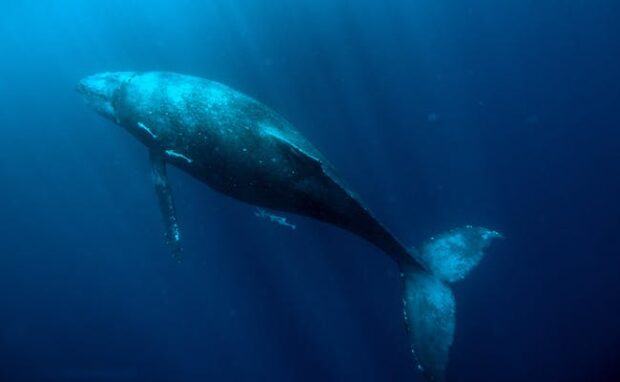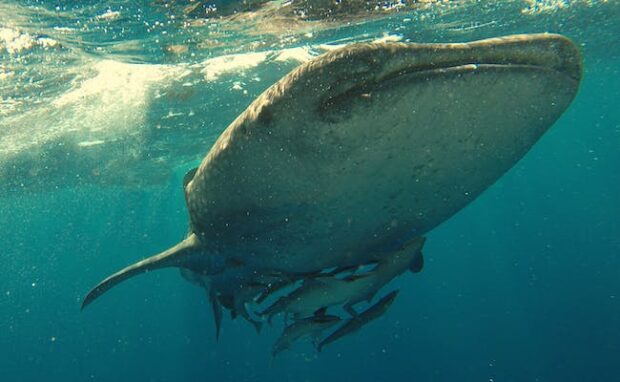Scientists succeed in whale communication
Scientists from UC Davis, the Alaska Whale Foundation, and the Search for Extraterrestrial Intelligence (SETI) succeeded in communicating with whales. They sailed a boat off, sent out “a contact call,” and attracted a humpback whale. Later, they have been sending contact calls at varying intervals, showing signs that the animal slightly understands the researchers.
You could meow or bark at a cat or dog and not get a response. However, these scientists developed a way to elicit one from one of the largest mammals. Their research will help us understand whales and perhaps other animals in the future. More importantly, SETI might succeed in the ultimate goal of whale communication: seeking space alien life!
This article will elaborate on how scientists succeeded in rudimentary whale communication. Later, I will explain how another group used AI to create a separate whale translator.
How did “whale communication” work?

Scientists from the organizations mentioned road a boat off the coast of Alaska and sent out whale “contact calls” to see if any would respond. Business Insider said they are similar to human greetings.
Whales use them to call over fellow whales and let each other know where they are. They recorded them from a small pod of whales before their encounter.
“They are one of the most common signals within the humpback whale social sound repertoire,” study co-author Fred Sharpe told Business Insider.
Later, they attracted a humpback whale named Twain. Scientists emitted the same contact call 36 times at varying intervals for the next 20 minutes.
You may also like: AI may help us understand what cats say
Fortunately, Twain responded to the call each time and matched the shifting intervals. If the scientists played a call and waited 10 seconds, the marine mammal also waited 10 seconds before replying.
“It certainly felt like we had been heard,” Sharpe said. “And we hope that she felt the same way, too.” Also, lead author Brenda McCowan stated, “We believe this is the first such communicative exchange between humans and humpback whales in the humpback ‘language.’”
The researchers used samples from a pod that included Twain, the whale. Consequently, they might have been communicating with Twain using its signal. “We might’ve been playing back her own hello to her,” Sharpe said.
How does whale communication relate to extraterrestrial life?

The Search for Extraterrestrial Intelligence wants to see whether there’s alien life in space, so why did it focus on whale communication? SETI principal investigator Laurence Doyle believes it’s an important step to understanding alien speech.
“An important assumption of the search for extraterrestrial intelligence is that extraterrestrials will be interested in making contact, and so target human receivers,” he explained. That is why he is working with UC Davis and the Alaska Whale Foundation to create intelligence filters from whale communication.
“If extraterrestrials are out there, sending us signals, trying to communicate, we might miss them if we don’t know what to look for,” Doyle told Business Insider. Intelligence filters could help us verify such signals.
“There are diverse intelligences on this planet, and by studying them, we can better understand what an alien intelligence might be like because they’re not going to be exactly like ours,” McCowan said. If a signal is intelligible based on whale research, it’s likely worthwhile to respond.
How did AI enable whale communication?

Artificial intelligence could match whale sounds with our speech. Whales have a complex communication system that uses 2-second clicks called codas.
David Gruber and his research team believe we could match those noises with our language. That is why they formed the Cetacean Translation Initiative or CETI. Here’s how it works:
You may also like: How to Block a Number
- The group deployed sensor arrays to locate and record whales.
- Then, they attached recording devices to whales to identify who was talking to whom.
- Also, the researchers will deploy aquatic drones to observe these sea creatures.
- CETI also flew aerial drones to monitor these animals.
This project will collect enormous amounts of data that will take ages to analyze and match with human language. Hence, Gruber and his team will use a large language model like GPT-3.
It contains millions of words that it could match to whale codas. As a result, the whale researchers hope it will help them understand and communicate with these majestic creatures.
Conclusion
Scientists demonstrated successful whale communication for the first time. They sent out whale contact calls and attracted one named Twain. Then, they proceeded to share contact calls with the creature for hours.
They believe it is the first step towards truly communicating with animals. However, we have a long way to go before we can share stories with these creatures!
Learn more about this whale communication study by reading its PeerJ webpage. Also, check out the latest digital tips and trends at Inquirer Tech.